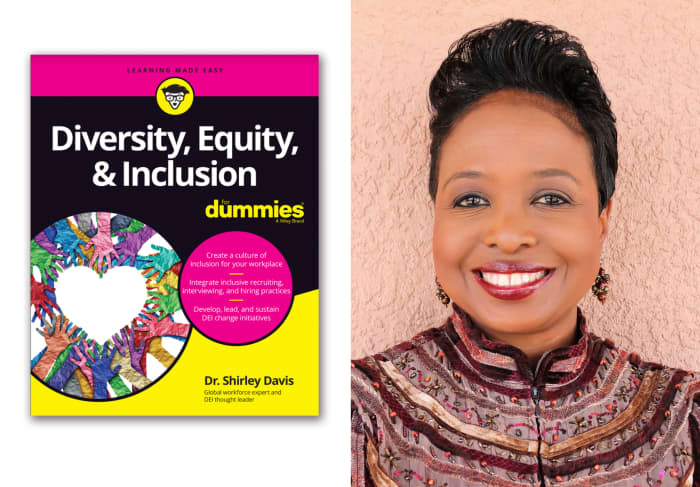#BookWatch: How you can find strength and allies to confront stereotypes, discrimination and microaggressions

Table of Contents
“BookWatch: How you can find strength and allies to confront stereotypes, discrimination and microaggressions”
If you’re ‘the only one’ at work, in a classroom or an event, these tips will help you feel not so alone.
Have you ever been in a meeting or at an event where you were the only person of color, the only woman, the youngest, or the only ……? You fill in the blank. How did it make you feel? How did you respond?
In the many instances when I found myself in that position of “the only one,” here is what I experienced:
- My ideas were dismissed or I wasn’t asked for my opinion at all;
- Insensitive comments were made and no one called it out. You don’t want to be the “DEI (diversity, equity and inclusion) police,” so you don’t say anything either;
- I didn’t always get invited to lunch or after-work activities, or the meeting after the meeting with members of my team;
- I wasn’t given the unwritten rules of how to navigate certain situations or deal with certain leaders, while my counterparts were;
- It was assumed that I would be speaking on behalf of everyone in my identity group.
All of these are considered microaggressions — subtle verbal and nonverbal slights, insults, indignities, and denigrating messages directed toward a person due to their group membership, whether age, race, gender or other attributes.
“ Microaggressions can be seen as innocent harmless comments, but they actually reinforce stereotypes and are a form of discrimination. ”
Microaggressions can be seen as innocent harmless comments, but they actually reinforce stereotypes and are a form of discrimination. And unfortunately they are most prominently reported among Black Americans, other people of color, and women.
A Gallup Panel web study completed by 36,463 U.S. adults, aged 18 and older found that across all microaggressions measured, Black Americans were much more likely than white, Hispanic and Asian-Americans to report these experiences. On most measures, Asian and Hispanic adults were slightly more likely than white adults to report these experiences with microaggressions. And, according to the “Women in the Workplace” report from McKinsey & Company and LeanIn.org, about 64% percent of all women reported they experienced microaggressions at work. That number jumped to almost 90% when women frequently found themselves in “only” situations.
Read: Yes, women of color are underfunded. Yes, it’s bad for the economy. Now it’s time to do something about it.
Those of us who have been “the only one” at the table and have experienced these and other negative effects report that they can leave one feeling uncomfortable, self-conscious and emotionally taxed. It certainly doesn’t make you feel that you can truly “bring your full self to work,” which has become the mantra of many companies, and it doesn’t create a sense of belonging, but rather, a sense of isolation and aloneness.

So how do you deal with being the only one?
Here are five strategies that worked for me to overcome these negative effects:
- I took my power back by drowning out the negative noise from outside and within. I stopped allowing other people’s opinions of me to define my sense of self-worth and got clear on my purpose, my value, and my unique skills and talents.
- I developed the courage to speak up and to confront others when their comments or behaviors were egregious and personally hurtful. I chose my battles wisely. I learned how to confront the offenders at the right time, with the right tone and choice of words, and with the right mindset, and it made all the difference in preserving the relationship. In some cases, I had to escalate the issue to senior leadership and HR.
- I drew on the strength, advice, and support of my personal board of advisers and sought out allies who already had a seat at the table and were willing to coach me and advocate on my behalf.
- I learned to use “being the only one” to my advantage by seizing the opportunity to shine and showcase my talents, expertise and fresh ideas. I found ways to insert my unique experiences that I believed would benefit clients, customers, and workers who looked like me.
- In situations when my employer did not recognize my value after I tried some or all of these tips repeatedly, I exercised my next option: I sought out an employer who was more welcoming and inclusive and who would recognize and appreciate my gifts and talents.
I know it can be daunting and exhausting to deal with these issues of being “the only one.” It takes courage, patience, perseverance, and being in the right environment where inclusion and belonging are valued and lived. Just know that you deserve to receive what you worked hard for, and you must be your biggest advocate.
Shirley Davis is a president and CEO of SDS Global Enterprises, specializing in human resources strategy, talent management, leadership effectiveness, culture transformation and diversity, equity, and inclusion. She is the author of Diversity Equity & Inclusion For Dummies (Wiley, 2022) and Living Beyond “What If? : Release the Limits and Realize Your Dreams” (Berrett-Koehler Publishers, 2021).
More: ‘The startup world wasn’t created for someone like me.’ This Black woman entrepreneur has some choice words for the ‘tech bros’ of venture capital.
Also read: The long history of racism haunts Black professionals, and the best places to work in America recognize and respect this
By
Shirley Davis
If you liked the article, do not forget to share it with your friends. Follow us on Google News too, click on the star and choose us from your favorites.
For forums sites go to Forum.BuradaBiliyorum.Com
If you want to read more News articles, you can visit our News category.




